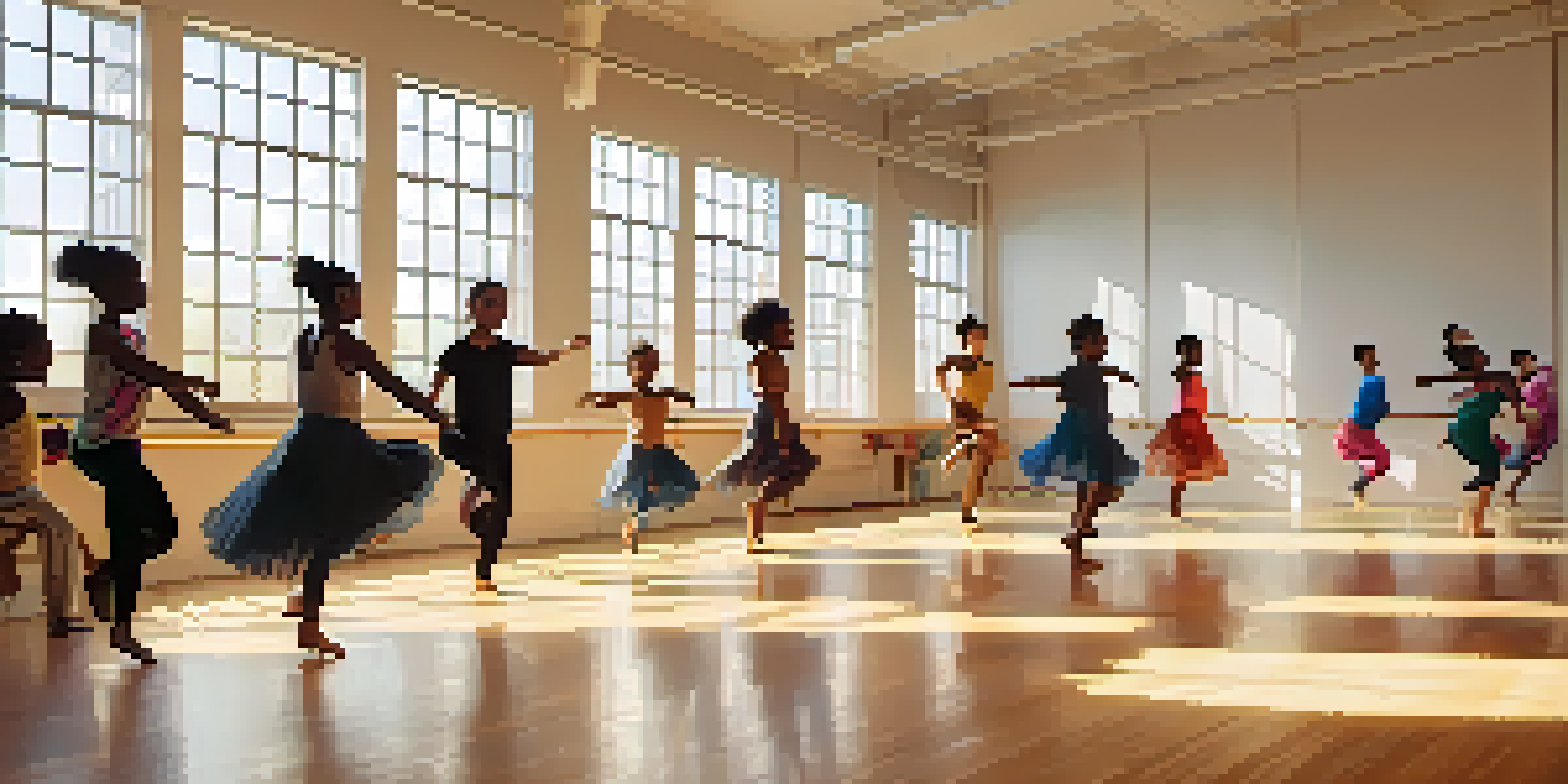Exploring Dance Therapy: A Path to Emotional Healing

What is Dance Therapy and How Does It Work?
Dance therapy is a form of expressive therapy that uses movement to promote emotional, cognitive, and physical integration. By engaging in dance, individuals can express feelings that might be difficult to articulate with words. This form of therapy is often guided by a trained professional who understands both the art of dance and the intricacies of mental health.
Dance is the hidden language of the soul.
At its core, dance therapy focuses on the connection between body and mind, tapping into the natural rhythm of our emotions. The process encourages participants to explore their feelings through movement, allowing for a deeper understanding of themselves. For many, this leads to insights that can be transformative.
Imagine dance therapy as a bridge between emotions and expression—a place where you can explore your innermost feelings without the constraints of language. This unique approach often leads to breakthroughs in emotional healing, making it a valuable tool for those navigating trauma or stress.
The Historical Roots of Dance Therapy
Dance therapy has its roots in the early 20th century when pioneers recognized the therapeutic potential of movement. Influenced by the ideas of the time, such as the importance of holistic health, these early practitioners began to explore how dance could heal emotional wounds. This historical context sets the stage for understanding its evolution.

The field gained momentum in the 1940s and 1950s when formal training programs started to emerge. It was during this period that dance therapists began to establish a framework for their practice, drawing from psychology and the arts. This blend of disciplines helped solidify dance therapy's place within the broader mental health community.
Dance Therapy Enhances Emotional Healing
By using movement as a form of expression, dance therapy helps individuals articulate complex emotions and promotes emotional healing.
Today, dance therapy is recognized as a legitimate therapeutic approach, with numerous studies supporting its benefits. As we continue to explore its historical roots, we see how far it has come and the significant impact it has on emotional healing.
Benefits of Dance Therapy for Emotional Healing
Dance therapy offers numerous benefits, particularly for those dealing with emotional challenges. One of the most significant advantages is its ability to reduce stress and anxiety. By moving the body and expressing feelings through dance, individuals can release pent-up emotions and tensions, providing a sense of relief.
The body says what words cannot.
Additionally, dance therapy enhances self-awareness and body confidence. Participants often find that as they move, they become more in tune with their emotions, leading to increased understanding and acceptance of themselves. This newfound awareness can foster a sense of empowerment and resilience.
Furthermore, dance therapy promotes social connection, as it often takes place in group settings. Sharing this creative space can build trust and camaraderie among participants, creating a supportive community. Ultimately, these benefits contribute to a more profound emotional healing journey.
How Dance Therapy Differs from Traditional Therapy
While traditional talk therapy primarily relies on verbal communication, dance therapy adds a physical dimension to the healing process. This approach allows individuals to express emotions that might be too complex or overwhelming to articulate. The body becomes a canvas of expression, making it easier to process feelings.
Moreover, dance therapy can often be more engaging for those who may find sitting and talking challenging. For children, adolescents, or anyone who struggles with verbal communication, movement can be a more natural way to express themselves. This difference makes dance therapy appealing to a broader audience.
Accessible to All Ages and Backgrounds
Dance therapy is a versatile approach suitable for individuals of all ages, making it an inclusive option for those seeking emotional support.
It's important to note that dance therapy doesn't replace traditional therapy; rather, it complements it. Many practitioners recommend integrating both approaches for a well-rounded therapeutic experience, allowing clients to tap into their emotional world through multiple avenues.
Common Techniques Used in Dance Therapy
Dance therapists employ a variety of techniques tailored to individual needs, often adapting their methods based on the client's background and emotional state. Some common techniques include improvisational dance, where participants move freely to music, allowing for spontaneous expression. This technique encourages creativity and can lead to unexpected insights.
Another popular method is guided imagery movement, where the therapist invites the participant to visualize a scenario and express it through dance. This technique helps bridge the gap between imagination and physical expression, offering a unique way to explore feelings. It can be particularly effective for those dealing with trauma or anxiety.
Additionally, structured dance sequences may be used to help clients explore specific emotions or themes. By creating a choreographed routine, participants can work through their feelings in a more focused manner. These diverse techniques showcase the versatility of dance therapy in addressing various emotional challenges.
Who Can Benefit from Dance Therapy?
Dance therapy is accessible to individuals of all ages and backgrounds, making it a versatile option for emotional healing. Children, adolescents, adults, and seniors can all find value in this expressive form of therapy. For example, children struggling with anxiety or behavioral issues may benefit from the non-verbal expression that dance offers.
Moreover, those experiencing trauma, depression, or stress-related disorders often find dance therapy to be a safe outlet. The movement encourages the release of emotions that may be trapped, allowing for healing to take place. This makes it a suitable option for individuals who have faced significant life challenges.
Combines Movement and Traditional Therapy
Dance therapy complements traditional talk therapy by adding a physical dimension, allowing for deeper emotional exploration.
Even those without a background in dance can participate and benefit from dance therapy. The focus is on expression rather than skill, making it an inclusive experience. Ultimately, anyone seeking emotional healing can explore the transformative power of dance therapy.
Getting Started with Dance Therapy
If you're considering dance therapy, the first step is to find a qualified therapist who specializes in this field. Look for professionals with relevant credentials and experience in both dance and therapeutic practices. Researching their background can help ensure a good fit for your needs and comfort level.
Once you've found a therapist, be prepared for an introductory session where you'll discuss your goals and expectations. This initial meeting is essential for establishing a rapport and understanding how dance therapy can best serve you. Your therapist will guide you through the process, ensuring a supportive environment.

Lastly, approach dance therapy with an open mind and a willingness to explore. Remember, it’s not about being a great dancer; it's about expressing yourself and unlocking your emotions through movement. Embrace the journey, and you may find emotional healing in ways you never imagined.